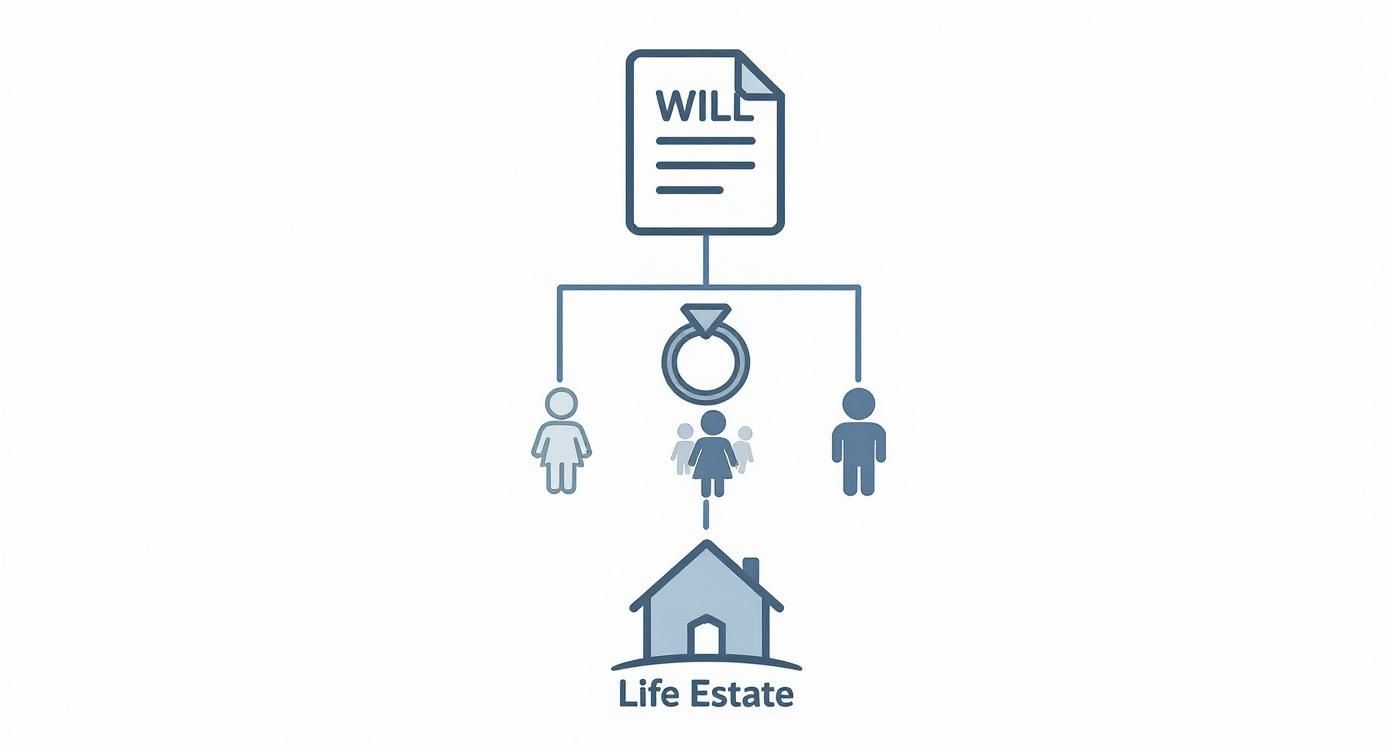Estate planning is complicated enough, but when you bring a blended family into the mix, it becomes a unique challenge requiring both legal precision and deep compassion. The goal is simple: create a legal strategy that protects your current spouse while also making sure your children from previous relationships receive the inheritance you intend for them.
This is critical because Texas law doesn't automatically recognize stepchildren as heirs. If you rely on a generic will or have no will at all, you could accidentally disinherit the very people you want to protect. A carefully built plan using wills, trusts, and clear communication is the only way to prevent conflict, honor your wishes, and provide peace of mind for everyone you love.
Why Standard Estate Plans Fail Blended Families

Creating a future for a blended family is an act of love, but let's be blunt: Texas inheritance laws were not designed for your family's unique structure. When you pass away without a specific plan—a situation known as dying "intestate"—the state steps in with a rigid, one-size-fits-all formula for distributing your assets. In simple terms, dying intestate means you passed away without a valid will.
This default plan often creates outcomes that are the complete opposite of what most people in blended families actually want.
The root of the problem is that under the Texas Estates Code, stepchildren have absolutely no legal right to inherit from a stepparent. This oversight can lead to a heartbreaking—and surprisingly common—scenario.
A Common Pitfall for Remarried Couples: A Realistic Scenario
Let's walk through a realistic example to see how this works in practice. Meet Mark and Sarah, a happily remarried couple in Texas. Mark has two children from his first marriage, and Sarah has one from hers. They've built a life together, owning a home and sharing joint savings accounts. Like so many couples, they assume their assets will simply go to the surviving spouse, who will then "do the right thing" and provide for all the children.
It's a nice thought, but it's not how the law works.
If Mark passes away without a specialized estate plan, here’s what could happen under Texas law:
- Assets Pass to Sarah: Under Texas's community property laws and default rules, Sarah, his surviving spouse, likely inherits Mark's share of their joint property. Any separate property Mark owned before the marriage might be split between Sarah and his biological children only, potentially forcing the sale of cherished assets.
- The Assets Become Sarah's: The property Sarah inherits is now legally hers, with no strings attached.
- The Unintended Consequence: When Sarah eventually passes away, her will—or the state's intestacy laws if she has no will—directs all of her property, including what she inherited from Mark, only to her biological child.
- Mark’s Children are Disinherited: Legally, Mark’s children get nothing from their father's legacy that passed to Sarah. They have been completely, though unintentionally, disinherited.
This isn't malicious. It’s a failure of a legal system that hasn't kept up with modern family dynamics. And this isn't a rare problem. According to the U.S. Census Bureau, approximately 16% of children in the United States live in blended families. Millions of families are navigating these exact challenges, where state laws simply don't reflect their intentions.
Default Inheritance vs. Your Intentions in a Blended Family
The table below shows the stark contrast between what Texas law dictates (intestacy) and what you likely want for your family. This is where things go wrong without a proper plan.
| Asset | What Happens Without a Will (Texas Intestacy) | Your Likely Intention | Potential Conflict |
|---|---|---|---|
| Family Home | Surviving spouse may have rights, but ownership could be split with the deceased's biological children. | The surviving spouse lives there for life, then the home is sold and split among all children. | Stepchildren can force the sale of the home, displacing the surviving stepparent. |
| Bank Accounts | Funds go to the surviving spouse and/or the deceased's biological children. | The surviving spouse has access to funds for living expenses, with the remainder eventually going to all children. | Mark's kids get nothing from the joint account after Sarah passes. |
| Retirement (IRA/401k) | Goes to the named beneficiary. If it's the spouse, it becomes their property to leave to their own kids. | Spouse is the primary beneficiary for their security, but a trust ensures the remainder goes to all children. | The surviving spouse's will may leave everything to their biological children, disinheriting stepchildren. |
| Personal Items | Distributed among legal heirs (spouse and biological children). | Sentimental items are distributed thoughtfully among all children and stepchildren. | Heirlooms and personal property from a first marriage end up with the new spouse's family. |
This table isn't just a list of legal outcomes; it's a roadmap of potential family heartbreak. Each row represents a possible fight, a misunderstanding, or a permanently broken relationship. The legal mess often creates deep emotional wounds. Children from a previous marriage can feel abandoned or intentionally cut out, even when that was the last thing their parent wanted. A surviving stepparent gets caught in the middle, torn between protecting their own financial future and honoring the memory of their late spouse.
Drafting a Will That Protects Everyone You Love
A will is the bedrock of any estate plan, but for blended families, it needs surgical precision. A simple, well-intentioned phrase like "I leave everything to my spouse" can become a legal landmine, unintentionally disinheriting children from a previous marriage. Getting your will right isn’t just about legal paperwork; it’s an act of profound care for every single person you love.
This means you have to get specific. Way more specific than you might think. Your will is a set of legal instructions, and clarity is your greatest weapon against future conflict and heartache. While modern tools can help with the basics, like exploring AI's role in modern legal document drafting, the core strategy must be ironclad and tailored to your family.
Be Explicit and Unambiguous
The number one rule when drafting a will for a blended family is to eliminate all ambiguity. Never assume a court will understand your family's unique dynamics or what you really meant. Your will has to spell everything out in plain English.
Here’s what that looks like in practice:
- Identify Everyone by Name: Don't just say "my children." List your current spouse, all your biological children, any adopted children, and your stepchildren by their full legal names.
- Clearly Define Relationships: Next to each name, state the relationship (e.g., "my daughter, Jane Doe," or "my stepson, John Smith"). This prevents any confusion, especially if names are similar.
- State Your Intent: Be crystal clear about who gets what. Don't leave assets to a generic group. Specify which assets go to which people or exactly how things should be divided among them.
This level of detail is non-negotiable, especially under Texas Estates Code, Section 22.015, which defines a "child" for inheritance purposes. The statute does not automatically include stepchildren, so your will is the only place to legally establish your intention to provide for them.
A Practical Solution: The Life Estate
One of the most powerful tools for blended families is the life estate. In plain English, a life estate is a legal arrangement that splits the ownership of a property. It lets one person (the "life tenant") use and live in the property for their entire lifetime. After they pass away, the property automatically transfers to other people you’ve named (the "remaindermen").
Let’s go back to our example family. Mark wants his wife, Sarah, to be able to stay in their home after he’s gone. It’s her home, too. But he also wants to make sure the house—a significant asset he brought into the marriage—ultimately goes to his two biological kids.
A life estate solves this perfectly. Here’s the step-by-step guidance on how it works:
- Mark's Will: He drafts his will to grant Sarah a life estate in the family home.
- Sarah's Rights: As the life tenant, Sarah can live in the house for the rest of her life. She’s responsible for its upkeep and property taxes, but she can't sell it or leave it to her own child in her will.
- The Children's Rights: Mark's children are named as the remaindermen. Their inheritance is locked in. The moment Sarah passes away, the life estate ends, and Mark's children become the full, undisputed owners of the property.
This strategy protects the surviving spouse from being displaced while guaranteeing the deceased's children receive their intended inheritance. It completely sidesteps the risk of the property being redirected to the new spouse's heirs. To get a better sense of how these documents fit into a larger strategy, you can learn more about the importance of wills in Texas estate planning in our detailed guide.
While a will is a vital first step, it’s not always enough. For even greater control and flexibility, especially with complex assets or tricky family dynamics, a trust might be the better tool for the job.
Leveraging Trusts for Greater Control and Flexibility
While a well-drafted will is essential, trusts offer a level of control and protection that a will simply can't match on its own. Think of a trust as a secure legal container you create right now to hold assets, complete with its own rulebook for how everything is managed and distributed. A will, by contrast, is a set of instructions for what happens after you're gone.
This is a game-changer in estate planning for blended families. Trusts give you the power to provide for your surviving spouse while also building a legal fence around your children's inheritance. This isn't about a lack of faith in your partner; it's about creating a crystal-clear, legally binding structure that prevents future misunderstandings and protects everyone. If you're new to the concept, understanding why setting up a trust can be one of the smartest moves a Texas family can make.
Demystifying Marital Trusts
One of the most effective tools we use for blended families is the Marital Trust. While there are a few different kinds, they all work toward the same goal: providing for your surviving spouse for the rest of their life while making sure the assets you leave behind eventually go to your chosen beneficiaries, like your children from a previous relationship.
A popular and incredibly useful version of this is the Qualified Terminable Interest Property (QTIP) Trust. The name sounds technical, but the idea behind it is simple and compassionate.
- How it Works: You fund the trust with your assets—things like investments, real estate, or cash. When you pass away, the trust springs into action, following the rules you've already laid out.
- For Your Spouse: Your surviving spouse gets all the income the trust's assets generate for their entire lifetime. You can also give them access to the principal (the original assets) for specific needs you define, like healthcare or general well-being.
- For Your Children: Here's the key part: your spouse never legally "owns" the assets inside the trust. Once they eventually pass away, the trust terminates, and whatever is left gets distributed exactly as you wanted—straight to your children.
This structure brilliantly balances everyone's needs. Your spouse is financially secure, and your children’s inheritance is legally firewalled, safe from being spent down, misdirected, or passed to a new spouse if your partner remarries.
The diagram below shows how different legal tools, like wills and trusts, can be layered to direct assets to both a spouse and children, ensuring all parties are looked after.

This kind of multi-layered planning allows you to do things like give your spouse the right to live in the family home for life (a "life estate") while legally guaranteeing your children inherit the property down the road.
A Real-World Trust Scenario
Let's go back to Mark and Sarah. Mark wants to ensure Sarah is cared for, but he’s worried his life savings might not end up with his kids. Instead of relying on just a will, he decides to set up a QTIP Trust.
- Mark Establishes the Trust: He sits down with his attorney to create the trust, funding it with his investment portfolio and the title to their house.
- Mark Passes Away: The trust is now irrevocable. Sarah, as the income beneficiary, immediately starts receiving the quarterly dividends and interest from the investments. This income allows her to maintain her lifestyle without worry.
- A Financial Need Arises: A few years later, Sarah faces a major medical bill. The trust document Mark created allows the trustee (a trusted third party) to dip into the principal for her health needs, so the bill gets paid from the trust funds.
- Sarah Passes Away: The trust has fulfilled its purpose for Sarah. The remaining principal in the investment account, along with the house, is transferred directly to Mark's two children—just as he planned decades earlier. His legacy is secure.
By using a trust, Mark didn't just cross his fingers and hope for the best; he created a legally enforceable roadmap. Sarah was cared for generously, his children’s inheritance was guaranteed, and the potential for a painful conflict between his wife and kids was taken completely off the table. That is the kind of peace of mind a well-crafted trust delivers.
Making Thoughtful Guardianship Decisions

For blended families with minor children, no part of an estate plan feels more critical—or emotionally heavy—than deciding who will raise your kids if the unthinkable happens. This conversation isn't about assets or bank accounts. It's about your child's entire future, their stability, and their well-being during a time of unimaginable grief.
Leaving this decision up to a judge is a recipe for family conflict and uncertainty. You know your child best, and your voice should be the one that guides their future.
In Texas, these decisions involve a specific legal role you need to understand. When you name a guardian in your will, you are nominating who you want to become the managing conservator. This is the person your child will live with and who will make the major decisions about their upbringing, from school choices to doctor visits.
It's a profoundly personal choice that demands deep thought and brutally honest conversations, especially when weighing the role of a stepparent against other biological family members.
Stepparents vs. Other Biological Family
One of the toughest scenarios for parents in blended families is choosing between their new spouse (the child's stepparent) and another biological relative, like a sibling or grandparent. There’s no easy formula here. The only right answer is the one that's best for your child.
Let’s walk through a common situation. Maria has a 10-year-old son, Leo, from her first marriage. She is now happily married to David, who has been a wonderful stepfather to Leo for the last five years. Maria’s sister, Carla, also has a very close relationship with Leo. If Maria were to pass away, who should she nominate as Leo’s guardian?
- Nominating the Stepparent (David): This choice often provides the most stability. Leo could stay in his home, attend the same school, and keep his friends. David knows his daily routines, his fears, and his joys. The risk? If Leo's biological father is still in the picture and contests it, or if David’s bond with Leo isn’t as rock-solid as it appears.
- Nominating the Sibling (Carla): This keeps Leo with a blood relative, which some families deeply prioritize. Carla shares family history and traditions. But this would mean a massive upheaval for Leo—a new home, a new school, and a different life, all while grieving the loss of his mom.
The legal framework for this is laid out in Title 3 of the Texas Estates Code, which gives you the right to designate a guardian in a written declaration. The court gives your choice tremendous weight, but it isn't automatically binding—especially if the other biological parent is alive and deemed fit. Our guide on legal guardianship in Texas dives deeper into the court's process and criteria.
The Rights of a Surviving Biological Parent
This is a critical point that many people miss: a stepparent does not automatically gain custody rights over a stepchild.
If your child's other biological parent is still alive and has parental rights, they will almost always have the superior legal claim to custody. This is true regardless of who you nominate in your will.
Your nomination of a guardian really comes into play if both biological parents pass away. If you feel strongly that the surviving biological parent is unfit to raise your child, you must provide detailed, compelling evidence in your estate planning documents to support that claim. Be warned, this is a very high legal bar to clear and can easily lead to painful and expensive court battles that could be classified as Probate Litigation.
Making these decisions is never easy. It requires you to set aside adult emotions and focus with laser precision on one thing: what environment will allow your child to not just survive, but thrive, after a tragedy.
How to Prevent Conflict With Clear Communication
While ironclad legal documents like wills and trusts are the foundation of estate planning for blended families, they only solve for the technical side of the equation. True peace of mind comes from handling the human element with just as much care.
Open, honest communication is the single most powerful tool you have to prevent the misunderstandings and resentment that can fracture families after a loss. Your estate plan is an act of love, but if your family doesn’t understand the “why” behind your decisions, it can feel like the exact opposite.
A family meeting, though it may seem daunting, is a profound gift to your loved ones. It’s your chance to manage expectations and articulate your intentions, transforming a dry legal process into a meaningful family conversation.
Starting the Conversation
Bringing everyone together to discuss your estate plan isn't about asking for permission—it's about providing clarity. The goal is to explain your choices thoughtfully, reassuring everyone that the plan was designed to protect the entire family.
Here are a few ways you can break the ice on this sensitive topic:
- "We’ve recently updated our estate plan and wanted to share our thinking with you all. It’s important to us that you hear it directly from us."
- "Our family looks a little different from many others, and we've put a lot of thought into making sure everyone is cared for. We want to walk you through how we've done that."
- "This conversation might feel a little awkward, but we're having it because we love you all and want to prevent any confusion or hurt feelings down the road."
The statistics paint a pretty clear picture of why this is so critical. Research shows that blended families face a 40% higher rate of disputes compared to first-marriage families, often driven by complex emotional dynamics and a lack of clear communication. By talking now, you actively lower that risk for your own family. You can learn more about these findings and preventing disputes.
An Example of a Family Meeting in Action
Imagine Mark and Sarah gathering their children. Mark takes the lead, explaining that he set up a trust to provide for Sarah for the rest of her life, ensuring she can stay in their home and remain financially secure.
He then clarifies that after she passes, the remaining assets in the trust, including the house, will go to his biological children. By explaining this, he shows his children that he hasn't forgotten them, while also showing Sarah's child that his mother will be protected.
He can explain why he structured it this way—to balance his deep commitment to his wife with the promise he made to his kids. This kind of transparency can defuse potential resentment before it ever has a chance to build.
Key Takeaway
A proper estate plan for a blended family is more than a legal document—it's a preventative measure. It preserves family harmony by leaving no room for assumptions or disputes when emotions are already raw. Explaining your estate plan isn't just about the logistics of who gets what. It’s about sharing the values and love that guided your decisions. This conversation is your legacy just as much as your assets are.
Frequently Asked Questions
When it comes to estate planning for blended families, the same sensitive questions come up time and time again. These are the details that can keep you up at night. Let's tackle some of the most common concerns we hear from Texas families.
Can My New Spouse Alter a Trust I Set Up for My Children?
The short answer? No, not if you set it up correctly. If you create an irrevocable trust, its terms are locked in once it's funded. A trust that cannot be changed is called irrevocable. No one, including a new spouse, can change them. This is exactly why trusts are such a powerful tool for blended families—they act like a legal lockbox for your children's inheritance, guaranteeing your wishes are honored no matter what the future holds. A revocable trust, on the other hand, is a different story and could potentially be changed, so the type of trust you choose is absolutely critical.
What Happens if I Forget to Update an Old 401k Beneficiary?
This is one of the most common—and devastating—mistakes we see. Assets like 401(k)s, IRAs, and life insurance policies are controlled by the named beneficiary on the account, not by what your will says. If your ex-spouse from your first marriage is still listed, they get the money. Period. Your will is powerless to override it. This makes reviewing and updating your beneficiaries one of the most important things you can do.
How Should I Treat Adopted Children Versus Stepchildren in My Will?
Under Texas law, there’s a massive difference. According to the Texas Estates Code, Section 22.015, an adopted child is treated exactly the same as a biological child. They have full, automatic inheritance rights and are considered your legal heir.
Stepchildren, however, are not legally your heirs unless you explicitly name them in your will. To leave something to a stepchild, you must identify them by name and clearly state what you want them to receive. If you don't, Texas law gives them nothing if you die without a will.
Do Stepchildren Have Inheritance Rights in Texas Without a Will?
No, they do not. If you die without a will (which is called dying "intestate"), Texas has a strict, rigid formula for dividing up your property. Stepchildren are not included in that formula. Only your surviving spouse, biological children, adopted children, and other blood relatives have a legal right to inherit. Your will is the only tool you have to give inheritance rights to your stepchildren.
Feeling overwhelmed? We can help you build a plan that handles these complexities. Learn more about our services for Wills & Trusts or get a better handle on the Texas Probate Process. We can also assist with matters related to Guardianship.
If you’re facing probate in Texas, our team can help guide you through every step — from filing to final distribution. Schedule your free consultation today.







